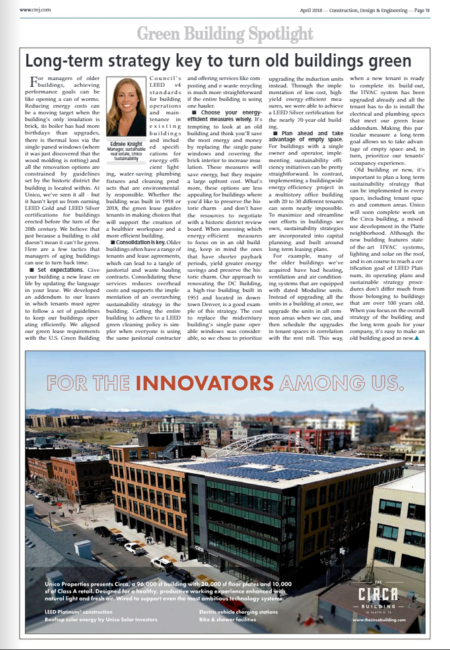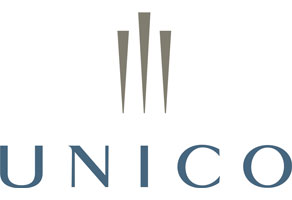 Can old building still be green? According to Edmée Knight, Manager, Sustainable Real Estate, it’s not only possible, it’s profitable.
Can old building still be green? According to Edmée Knight, Manager, Sustainable Real Estate, it’s not only possible, it’s profitable.
Learn how Unico is conquering the challenges around green energy and sustainability for older buildings in this article from the Colorado Real Estate Journal.
For managers of older buildings, achieving performance goals can be like opening a can of worms. Reducing energy costs can be a moving target when the building’s only insulation is brick, its boiler has had more birthdays than upgrades, there is thermal loss via the single-paned windows (where it was just discovered that the wood molding is rotting) and all the renovation options are constrained by guidelines set by the historic district the building is located within. At Unico, we’ve seen it all – but it hasn’t kept us from earning LEED Gold and LEED Silver certifications for buildings erected before the turn of the 20th century. We believe that just because a building is old doesn’t mean it can’t be green. Here are a few tactics that managers of aging buildings can use to turn back time.
Set expectations. Give your building a new lease on life by updating the language in your lease. We developed an addendum to our leases in which tenants must agree to follow a set of guidelines to keep our buildings operating efficiently. We aligned our green lease requirements with the U.S. Green Building Council’s LEED v4 standards for building operations and maintenance in existing buildings and included specifications for energy-efficient lighting, water-saving plumbing fixtures and cleaning products that are environmentally responsible. Whether the building was built in 1918 or 2018, the green lease guides tenants in making choices that will support the creation of a healthier workspace and a more efficient building.
Consolidation is key. Older buildings often have a range of tenants and lease agreements, which can lead to a tangle of janitorial and waste hauling contracts. Consolidating these services reduces overhead costs and supports the implementation of an overarching sustainability strategy in the building. Getting the entire building to adhere to a LEED green cleaning policy is simpler when everyone is using the same janitorial contractor and offering services like composting and e-waste recycling is much more straightforward if the entire building is using one hauler.
Choose your energy-efficient measures wisely. It’s tempting to look at an old building and think you’ll save the most energy and money by replacing the single-pane windows and covering the brick interior to increase insulation. These measures will save energy, but they require a large upfront cost. What’s more, these options are less appealing for buildings where you’d like to preserve the historic charm – and don’t have the resources to negotiate with a historic district review board. When assessing which energy-efficient measures to focus on in an old building, keep in mind the ones that have shorter payback periods, yield greater energy savings and preserve the historic charm. Our approach to renovating the DC Building, a high-rise building built in 1951 and located in downtown Denver, is a good example of this strategy. The cost to replace the midcentury building’s single-pane operable windows was considerable, so we chose to prioritize upgrading the induction units instead. Through the implementation of low-cost, high-yield energy-efficient measures, we were able to achieve a LEED Silver certification for the nearly 70-year-old building.
Plan ahead and take advantage of empty space. For buildings with a single owner and operator, implementing sustainability efficiency initiatives can be pretty straightforward. In contrast, implementing a building wide energy-efficiency project in a multistory office building with 20 to 30 different tenants can seem nearly impossible. To maximize and streamline our efforts in buildings we own, sustainability strategies are incorporated into capital planning and built around long-term leasing plans.
For example, many of the older buildings we’ve acquired have had heating, ventilation and air-conditioning systems that are equipped with dated Moduline units. Instead of upgrading all the units in a building at once, we upgrade the units in all common areas when we can, and then schedule the upgrades in tenant spaces in correlation with the rent roll. This way, when a new tenant is ready to complete its build-out, the HVAC system has been upgraded already and all the tenant has to do is install the electrical and plumbing specs that meet our green lease addendum. Making this particular measure a long-term goal allows us to take advantage of empty space and, in turn, prioritize our tenants’ occupancy experience.
Old building or new, it’s important to plan a long-term sustainability strategy that can be implemented in every space, including tenant spaces and common areas. Unico will soon complete work on the Circa building, a mixed-use development in the Platte neighborhood. Although the new building features state-of-the-art HVAC systems, lighting and solar on the roof, and is on course to reach a certification goal of LEED Platinum, its operating plans and sustainable strategy procedures don’t differ much from those belonging to buildings that are over 100 years old. When you focus on the overall strategy of the building and the long-term goals for your company, it’s easy to make an old building good as new.
